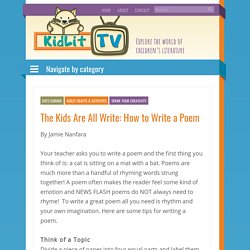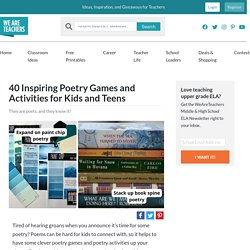

Search this poetry database for a poem with which you would like to practice. Remember to give the poet credit for their work.
4. After you have practiced using other poets poetry, this website will instruct you on how to create your own poem.
5. Use this article to begin inquiring into other robotic programming tools you might use in order to enhance your learning. Write a paragraph to convince me to get one for the library's Makerspace and S.T.E.A.M. area. What subjects can we use it with?
6.
MaKey MaKey - An Invention Kit for Everyone. YouTube. Poetry Out Loud. The Kids Are All Write: How to Write a Poem - KidLit TV. By Jamie Nanfara Your teacher asks you to write a poem and the first thing you think of is: a cat is sitting on a mat with a bat.

Poems are much more than a handful of rhyming words strung together! A poem often makes the reader feel some kind of emotion and NEWS FLASH poems do NOT always need to rhyme! To write a great poem all you need is rhythm and your own imagination. Here are some tips for writing a poem. Think of a Topic Divide a piece of paper into four equal parts and label them 1. Choose Words Carefully Before you start writing your poem, make a list of words that describe your topic. Write Your Poem Use your list of words to begin writing your poem. Use Line Breaks Deliberately Line breaks let the reader know when to pause. Poem #1 We glided on the porch swing and ate warm bread Grandma watered the daisies The sun set Another summer day gone Poem #2 We glided on the porch swing and ate warm bread Grandma watered the daisies the sun set another summer day gone.
7 Examples Of Robots In The Classroom You Should Know. Kids file into their classroom, nervous to meet the new teacher.

But anxiety and apprehension quickly turn to curiosity and surprise when they see who it is — more accurately, what it is. Greeting them is Robin, a 23-inch-tall humanoid robot with a friendly expression on its facsimile-of-a-face. It's far more subdued-looking than other humanoids, some of which seem to be straight out of a psychedelic fever dream by Stanley Kubrick — or Sid & Marty Krofft. And that's by design. "Let's play a game!
" But as Robin leads them through one amusing activity after another, that's exactly what they unwittingly do — learn. A specially programmed Nao model from Softbank Robotics, Robin was part of a larger European research project called L2TOR (pronounced "el tutor") whose goal was to teach young children a second language (in Robin's case, English) using social robots. "Let's play another game," Robin says, in Dutch, to a little boy. "Red block" is spoken in English. Softbank Robotics. Poetry Games for the Classroom - 22 Creative Ideas. Some kids love poetry.

Their eyes light up when they get the chance to compose their own verses. But for others, poems are met with groans and grumbles. That’s where these fun poetry games and activities come in. Kids will be surprised at how accessible and meaningful poetry can be, no matter their age or interests. Before you start, check out our favorite poems for sharing with elementary students and middle and high school students!
We receive a few cents if you purchase using our links, at no cost to you. 1. For most of us, nursery rhymes were the first poems we read, and they’re the perfect place to start with poetry games. Learn more: Toddler Approved 2. Introduce poetry to little ones with a paper bag filled with several items of different sizes, shapes, textures, etc. Learn more: Bulldog Readers and Bobcats Blog. The Fun Way to Teach Poetry: Color Shape Poetry Writing.
7 Best Presentation Tools for Students. One of the best ways to get students using technology in your classroom is through presentations.

No matter what the topic, creating colorful slideshows and engaging materials helps students get their point across and gives them a chance to learn best practices for using software to help them organize their thoughts. But what tech should you rely on to get the job done? There are plenty of options to choose from. Here are some of the best presentation tools for students: 1. It gets a bad rap for being boring in meetings and a crutch for uninspired orators, but PowerPoint provides a lot of bang for the buck when it comes to teaching students some important presentation basics. Pro Tip: Remind your students that slides are for enhancing presentations, not just reading from verbatim, and you can help break the cycle of dull PowerPoint presentations for the next generation.